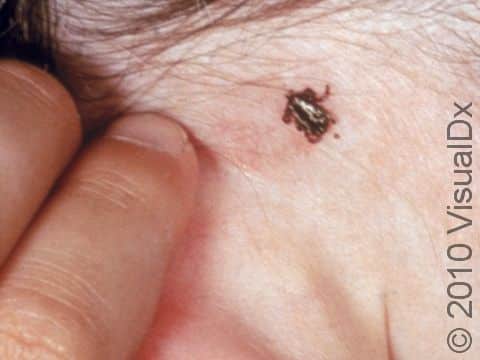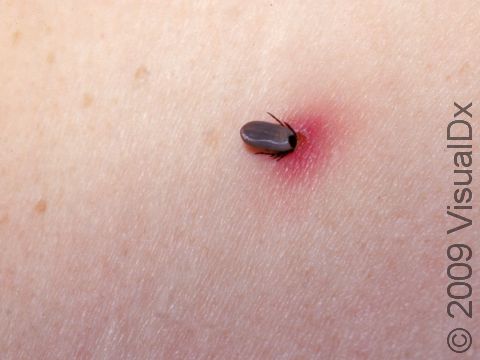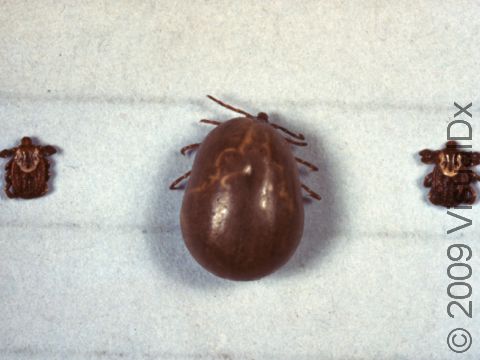Tick Bites, First Aid
Ticks are 8-legged creatures that live in wooded and grassy areas. Ticks attach themselves to a host, such as when a human brushes against leaves, grass, etc., with an awaiting tick on it. (Ticks cannot jump or fly.) Once on a host, the tick will typically move to a warm and moist location on the body (eg, an armpit, groin, back of the knee, hairline), where they bite through the host’s skin and feed off their blood.
The tick itself can be very small (almost impossible to see) or fairly large (about the size of a pencil eraser). Fully developed ticks have 8 legs, although they may have only 6 visible legs early in their developmental stage. Ticks have a small head in comparison to their round body, which is usually covered by a hard, thick outer shell.
Many ticks are harmless, but some carry pathogens such as bacteria and viruses that can cause illness in people (eg, Lyme disease, Rocky Mountain spotted fever, Colorado tick fever). Certain ticks can inject venom that causes temporary paralysis in their host, called tick paralysis.
Who's At Risk?
People who work in or spend time in wooded or grassy areas, particularly those who wear clothing that does not fully cover their body, such as shorts and short-sleeved shirts, and people who don’t wear insect repellant are most prone to tick bites.
Signs & Symptoms
The site of the tick bite typically looks like a small, reddish area that may or may not be raised, similar to a mosquito bite.
Within days, weeks, or months, the bite from an infected tick may develop a red ring (larger than 2 inches), often looking like a bull’s-eye, indicating possible infection with Lyme disease. Note, however, that the classic bull’s-eye lesion does not need to develop for a diagnosis of Lyme disease. In addition to a potential rash, the person may also have a fever or chills, as well as headache, fatigue, and muscles aches.
In the case of tick paralysis, the person may feel weakness or paralysis that moves up the body.
Self-Care Guidelines
First Aid Guide
To remove an embedded tick:
- Wash your hands.
- Clean tweezers by pouring antiseptic solution (eg, isopropyl alcohol) over them.
- With the cleaned tweezers, grasp the tick as close to its head or mouth as possible, and pull it straight out with a slow and steady motion. Be careful not to leave the head embedded in the skin, and make sure all parts of the tick are completely removed.
- Wash the area completely with soap and water.
After the tick has been completely removed, watch over the next few weeks for signs of infection or illness, particularly if the tick may have been attached for over 24 hours.
Prevention
The most important consideration regarding ticks is prevention of tick bites. While in wooded areas, tall grass, or brush, be sure to:
- Wear long pants and long sleeves.
- Wear your socks over the outside of your pant legs.
- Tuck your shirt into your pants.
- Wear light-colored clothes so that ticks can easily be spotted.
- Spray your clothes and exposed skin with insect repellant.
- Frequently check your clothes and skin for ticks.
It is important to remove an attached tick within 24 hours, if possible.
After being outdoors, once home, remove your clothes, shower, and thoroughly inspect all skin surface areas, including checking the skin of the scalp and behind the ears. Ticks can be quite small, so carefully evaluate all black or brown spots on the skin.
Treatments
If the entire tick was not successfully removed, a medical professional can remove the remaining portion of the tick.
Depending on your situation, your medical professional may decide to prescribe a course of antibiotic treatment such as oral doxycycline.
Visit Urgency
Seek emergency medical care if you experience any of the following:
- Signs of paralysis (numbness, tingling, weakness, and incoordination)
- Severe headache
- Chest pain
- Heart palpitations
- Trouble breathing
- Any other serious symptoms
Typically, there is no need to see a medical professional for a tick bite. However, if you attempt to remove a tick and part of it remains in the skin, seek medical attention.
Illness caused by ticks may not develop for days, weeks, or even months after the bite occurred. Seek medical attention if flu-like symptoms occur following a tick bite or if a pink or red bull’s-eye-like ring develops around the bite.
Following a tick bite, watch for signs of infection and seek medical care if any of these symptoms occur:
- A rash
- Increased pain
- Swelling
- Redness
- Flu-like symptoms
- Discharge or red streaks from the site of the bite
Trusted Links
Last modified on August 14th, 2024 at 3:08 pm

Not sure what to look for?
Try our new Rash and Skin Condition Finder


